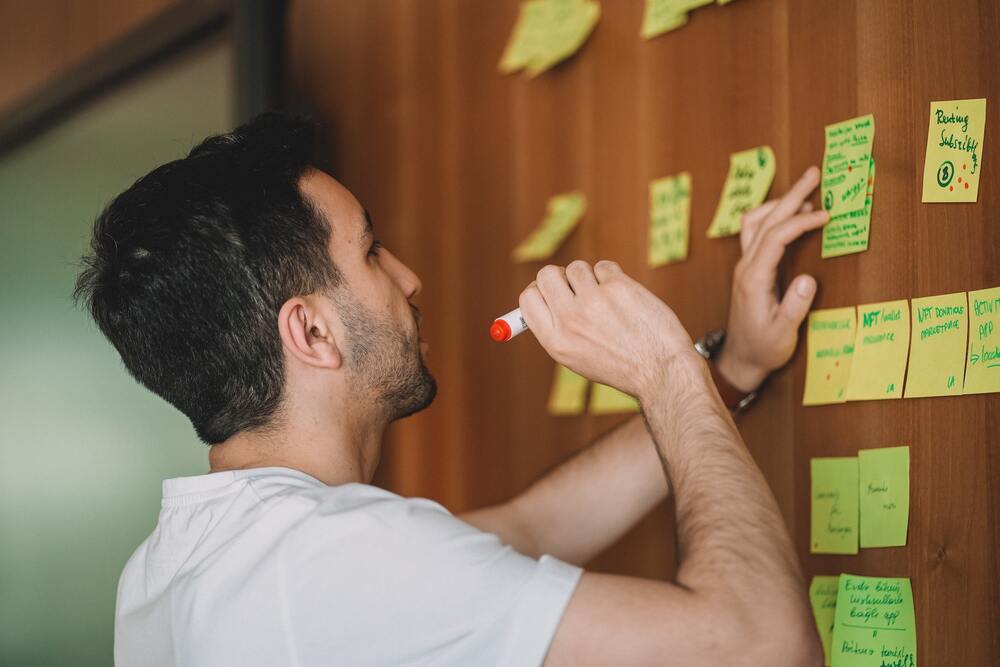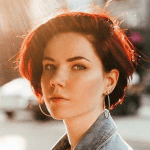Product Ideation: Process Explanation, Techniques, and Tools
Every product and every feature starts with an idea. Sometimes you are lucky, and your idea brights up on its own, but what do you do if the page is blank? Product ideation is the answer.
When you took your first steps in business and became an entrepreneur, you probably remember that everything started with an idea. Maybe it was something you came up with one day, acted on it, and grew into something real.
We often imagine being an entrepreneur as this simple process: from idea to plan and then to action. But coming up with ideas doesn’t always happen so naturally, especially when you are trying to ideate on purpose.
A romantisized vision tells us that an entrepreneur should come up with a geniuos idea on their own. In reality, a successful product often stems from a collective thought process
In this article, you’ll learn about the time-proven method of generating ideas for your business and its separate components, for example, features or new services. Let’s start with definitions and then take a closer look at the product ideation process.
What is product ideation?
To put it simply, product ideation is a collective process of generating ideas. You can think of it as brainstorming, but product ideation is a more complex and structured process that involves the whole team.
The romantic vision conveyed through success stories and movies usually shows us an entrepreneur who came up with an idea suddenly and unexpectedly. But in the real world, business ideas are often products of a collective thought process.
Product ideation is a collective process of generating ideas for your future product. We at Mobindustry involve people with different expertises, backgrounds and experiences to come up with the best ideas for products and features
Instead of holding the full product vision in your head, you involve each team member in the idea-generation process. Stakeholders, designers, developers, product managers, and other specialists can participate in the ideation process, determine what product they’re building, identify their key objectives, prioritize features, and analyze their feasibility.
The main goals of product ideation are to:
- Come up with ideas
- Evaluate and validate ideas
- Identify product goals
- Select the most important thoughts
Product ideation is integral to any product development process and happens regularly regardless of the product development stage. Let’s explore the new product ideation process and how to integrate it into your software product management flow.
Stages and process of product ideation
Product ideation happens during the sessions. You have to undergo no set number of sessions, so this depends on your team, goals, and project size. You can do ideation sessions for the whole product or separate features.
There are three main stages of product ideation:
- Idea generation
- Selection
- Implementation
Let’s discuss them in detail.
Idea generation
This is the initial stage of the ideation process. At this point, your main goal is to generate ideas with your team. You can use various techniques for that, but all of them will encourage your team members to think about the project and share their thoughts in a judgment-free environment.
Some teams see value in quantity and will focus on generating as many ideas as possible. They’ll accept any random thoughts because there’s a chance to find something brilliant there.
Other teams focus on fewer, better thoughts rather than their quantity. Regardless of your chosen approach, you will still need to get to the next stage and sift through these ideas.
During this stage, you don’t just rely on your team’s imagination or experience. User feedback for existing products or user research can be a valuable source of ideas. The same goes for competitor analysis and market research.
Selection
Now that you have a few thoughts or a whole pile of them, you can start the selection process. Discuss the ideas with your team and choose the best ones. You can dissect, merge and dismiss them until you develop a shortlist.
If you feel like you have too many good thoughts, and it’s hard to narrow the list down, think of your future development process and the feasibility of each idea. Which is critical for your business, and which is “nice to have”?
Discuss this with your technical team too, and go through an idea validation for a digital product, making sure your list is doable within your timeline and budget.
Implementation
Now, it’s time to implement the ideas you prioritized. Here, it’s very important not to overcomplicate the development process and implement ideas to a minimum viable degree. What do I mean?
Say, you have an idea for your app’s new block of features. For example, you have an ecommerce app, and you want to implement gamification. Instead of developing a full-blown mobile game inside your app, opt for a simple challenge in exchange for some bonuses.
First, it will allow you to test your idea with real users and see whether they’re interested at all. Second, your team will have a manageable task rather than an overwhelming project.
Product ideation should lead your team to actionable tasks and goals. If you have a big idea, keep it in mind, but start with smaller, manageable tasks.
Top product ideation techniques that work
There are lots of product ideation tools and methods:
- Storyboarding
- Brainstorming
- Brainwriting
- Mindmapping
- Focus groups
- SCAMPER
- Worst Idea
Storyboarding
This method encourages your team to express their ideas in the form of a story. Usually, your team will use pieces of paper to create visual stories and present their thoughts. Each story may have various outcomes and steps that lead to them.

This method allows you to visualize your user journey and determine the best way for them to achieve their goals in your product.
Brainstorming
This is a classic exercise where each participant shares their ideas out loud. To get the best results, involve 5-7 diverse specialists with different expertise, outlook and background.
Each brainstorming session needs a facilitator who creates a no-judgment but controlled environment where everyone can share their thoughts.
Brainwriting
This method is a lot like brainstorming, but instead of sharing ideas out loud, the participants have 5 minutes to write a list of solutions to a particular problem. Then, they pass their paper to the next person, and participants continue this cycle, building upon each other’s ideas.
The brainwriting activity ends when every participant has shared their ideas on each piece of paper. This exercise is great for people who are better at expressing their thoughts in written form.
Mind mapping
Similarly to storyboarding, mind mapping allows you to visualize your ideas and structure your thoughts. Mind mapping sessions start with a single central word or phrase. Then, participants write everything that came to mind in association with it.

Mind mapping allows you to add ideas infinitely and see the relationships and links between separate thoughts.
Focus group
As I mentioned, you don’t need to generate all ideas independently. Using a focus group that will try out your concept in a controlled environment can be invaluable, especially at the early stages of ideation.
Involve users as soon as possible, ask questions and use this feedback to build a user-centric product. This technique works for user experience testing of both new products and separate features.
SCAMPER
This technique allows you to get a different perspective on existing ideas and processes. With SCAMPER, you can re-shape ideas and make something new out of them, that will work better and be different from how everyone already does them.
SCAMPER is an acronym, so let’s discover the meaning for each letter:
- Substitute — replace a part of your concept or process with another for a better outcome
- Combine — merge two ideas into one for better efficiency
- Adapt — create a new process by applying another principle to it
- Modify — look at your problem from a different angle and cut everything that doesn’t matter for the end result
- Put to another use — find a way to repurpose your solution for other problems
- Eliminate — entertain the idea of eliminating some parts of your process or idea, and think of how this would affect the outcome
- Reverse — place your idea or process elements in a different order
You can find examples of this everywhere. For example, mobile banks eliminated the login with a password and replaced it with a simple biometric login, and Amazon was the first to introduce the one-click checkout.
Worst idea
Worst idea or reverse thinking can help you lift the pressure of generating only good ideas. Sometimes during brainstorming, people hold back because they feel the need to share a good idea. Reverse design thinking allows them to change their mindset and share the worst idea on how to solve an issue.
This trick allows you to eliminate judgment and discuss some ideas that might be overlooked because they’re deemed obvious.
Analogies
Analogies allow you to compare ideas and simplify complex concepts. To use an analogy, compare your idea or issue to a similar situation everyone is familiar with. Think of how you usually solve a problem in this familiar situation, and discuss whether there’s a similar solution to your problem.
How to implement product ideation in your team: tips and tricks
Now that we’ve talked about what techniques you can use to generate ideas for your product strategy, let me share a few best practices we use here at Mobindustry to ideate with our clients.
- Define a clear problem. Just coming up with random ideas may confuse you and your team. Make sure you state a concrete problem first so your team can develop better, actionable solutions.
- Focus on your users. As a product owner or entrepreneur, you must consider everyone’s interests, available resources, market conditions, etc. But your primary focus should be on your users when thinking about your product.
- Get a diverse team. Make sure to involve different people with contrasting experiences, outlooks, skills, and personal characteristics in your product ideation process.
- Put limits. Keep your team focused on a primary objective, and eliminate ideas that don’t align with it.
- Challenge the status quo. To achieve new results, you need to act differently. Challenge your existing processes and the status quo to determine what works and what doesn’t.
- Turn your ideas into reality. Make sure your ideas are attainable and you have a clear plan on how to execute them.
Final thoughts
The ideation process doesn’t need to be tiresome or anxiety-inducing. In this article, you’ve learned how to make it effective, goal-oriented, and focused on your customers.
We at Mobindustry can become a part of your ideation team — our experts have diverse experiences in various industries and have lots to bring to the table. We pay close attention to current trends, and our diverse experience prevents us from stagnating.
If you have an idea for your project but aren’t quite sure how to make it real or what product features it needs, we’ll be happy to assist. Mobindustry supports clients from the very first consultation to a successful release and maintenance. We’ll be able to turn your vision into an actionable plan that will work with any team and lead to a successful product.

